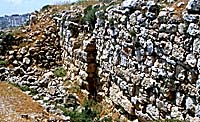 Jeremiah the prophet, bound in chains in the convoy of Judean exiles the conquering army was taking to Babylonia, is freed by the captain of the guard. Jeremiah goes to Mitzpa, near destroyed Jerusalem, where Gedalya, whom the Babylonian King Nebuchadnezzar had appointed governor over Judea.
Jeremiah the prophet, bound in chains in the convoy of Judean exiles the conquering army was taking to Babylonia, is freed by the captain of the guard. Jeremiah goes to Mitzpa, near destroyed Jerusalem, where Gedalya, whom the Babylonian King Nebuchadnezzar had appointed governor over Judea.
Jewish idealists and patriots who opposed the Babylonian occupation viewed Gedalya as a traitor and collaborator. In a sense they were right—Gedalya was working for the enemy. But Gedalya, like Jeremiah, understood that resistance to the conquers was hopeless. Better to accept the autonomy the Babylonians were offering and do what could be done to help the nation recover from the ravages of the war.
“Now it came to pass in the seventh month that Yishma’el the son of Netanya the son of Elishama, of the royal line, and some of the chief officers of the king, and ten men with him, came to Gedalyahu the son of Ahiqam to Mitzpa; and there they ate bread together in Mitzpa. Then Yishma’el the son of Netanya and the ten men that were with him arose and struck Gedalyahu the son of Ahiqam the son of Shafan with the sword and slew him” (Jeremiah 40:1-2).





